✈️ Beyond Biryani at 35,000 ft: The Journey of Airline Meals and the Search for Honest Flavor

Photo by Errakaaram
Explore India’s high-altitude culinary revolution—from biryani at 35,000 ft to clean-label condiments shaping sustainable aviation catering—discover in-flight meal innovations.
Why Airline Food Matters
It’s easy to underestimate the humble airline meal. Served in tight plastic trays with plastic cutlery, it often gets mocked online. But behind that tray is a world of aviation logistics, culinary science, and strict regulation. Airline food is engineered to be safe, tasty, and satisfying—despite altitude, humidity, and reheating.
Your taste buds dull significantly at altitude. Studies by Lufthansa and the Fraunhofer Institute found that our ability to perceive saltiness and sweetness drops by up to 30% in-flight. That’s why in-flight chefs adjust recipes: more seasoning, stronger spices, and umami-rich ingredients like soy sauce, mushrooms, and tomatoes help compensate for altitude-induced blandness.
And yes, tomato juice—a beverage many don’t enjoy on the ground—is one of the most requested drinks in the air because of this effect.
The Origins: Why Did Airline Meals Begin?
In the 1920s, airline food was a luxury reserved for the elite. The first recorded in-flight meal—sandwiches and fruit baskets—was served in 1919 by Handley Page Transport, marking the beginning of a culinary journey at 35,000 ft.
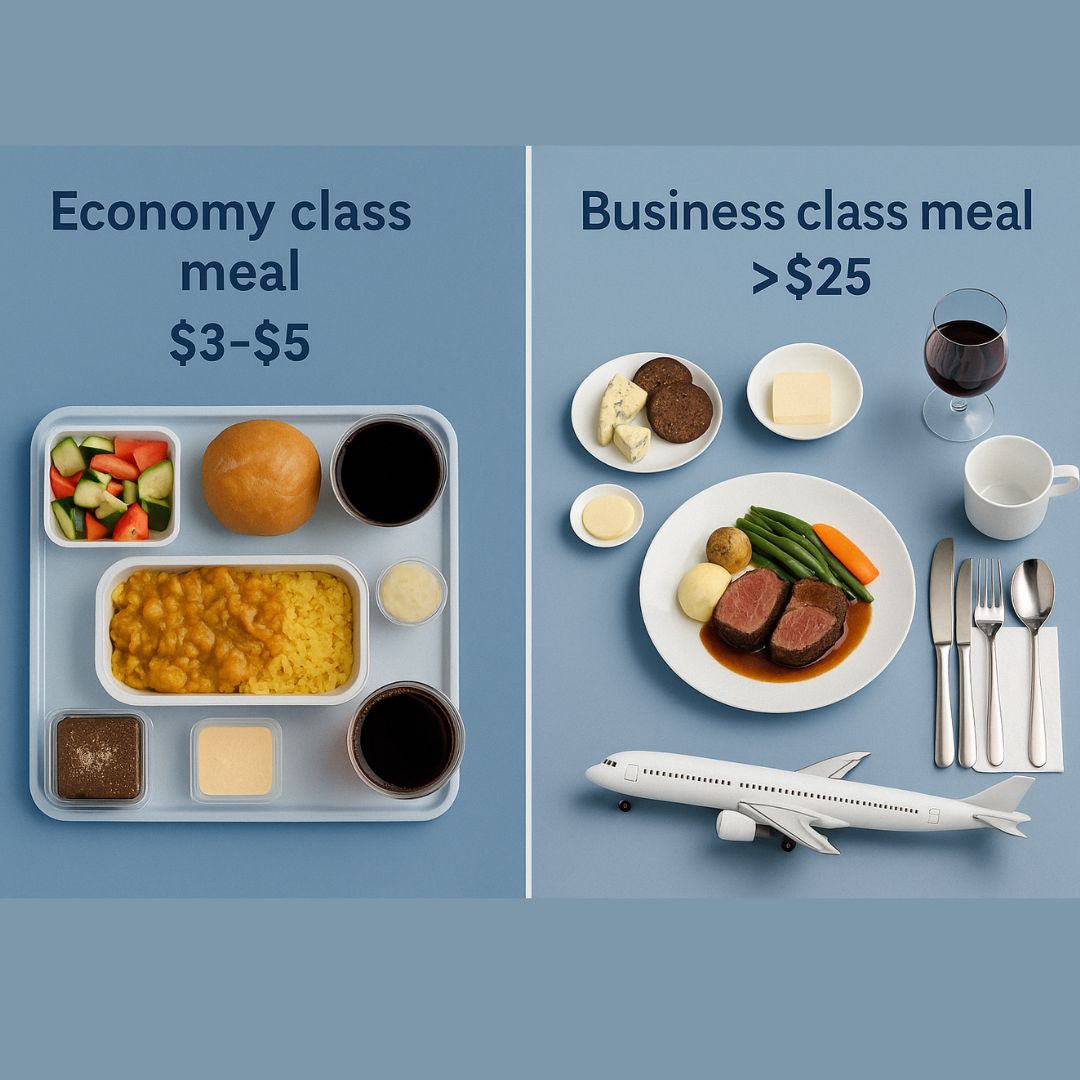
As commercial aviation expanded, meals became a competitive edge. By the 1950s and ’60s, long-haul flights featured full-service, multi-course menus—and even onboard chefs on prestige carriers like Pan Am and Air India.
In India, Air India was legendary for serving biryani and parathas on fine china with metal cutlery. But rising costs and the rise of low-cost carriers shifted the focus from opulence to operational efficiency.
Global Airline Food Today: A Logistics Marvel
Catering giants like LSG Sky Chefs and Gate Gourmet operate massive “cloud kitchens” adjacent to airports, where meals are cooked, blast-cooled for safety and texture, then trucked to aircraft gates hours before boarding.
- Remain safe for at least 10–12 hours
- Withstand chilling, transport, and reheating
- Comply with international and local food-safety regulations
Top carriers are raising the bar: Singapore Airlines lets premium flyers pre-select chef-curated dishes, while Emirates pairs first-class meals with vintage wines. Even budget airlines are upgrading menus to meet evolving passenger expectations.

How Safety and Taste Coexist at 35,000 Feet
Every airline meal must comply with HACCP standards—inspected by health authorities at both departure and arrival points—to ensure safety without compromising flavor.
Airlines also cater to special dietary needs: kosher, halal, vegan, Jain, and gluten-free meals are prepared in segregated areas to prevent cross-contamination.
- Kosher & Halal: certified and strictly separated
- Vegan & Jain: plant-based menus, no animal by-products
- Gluten-Free: dedicated preparation to eliminate traces
Temperature control is critical: cold items must stay below 5 °C, and hot dishes above 60 °C until plating or reheating—any lapse risks foodborne illness and fines.
To counter muted taste buds at altitude, chefs boost seasoning—Indian in-flight curries often pack extra chili and spice so they still zing at 35,000 ft.
Business and Branding: Why Food Still Matters
In-flight food isn’t just fuel—it’s a strategic investment in loyalty and brand perception.
Economy Class
Cost: $3–$5 per meal
Business Class
Cost: $25+ per meal
Brand Impact
Loyalty > Profit on F&B
Many premium carriers operate at a loss on catering, knowing that a memorable meal drives repeat bookings. Airlines like Air France, ANA, and Qatar partner with celebrity chefs to craft bespoke menus—think Parisian-inspired appetizers or Japanese kaiseki for Tokyo routes.
Route-specific dining is now table stakes: masala dosas on India departures, Sicilian antipasti for Rome-bound flights, or New York deli sandwiches on US coast-to-coast services.
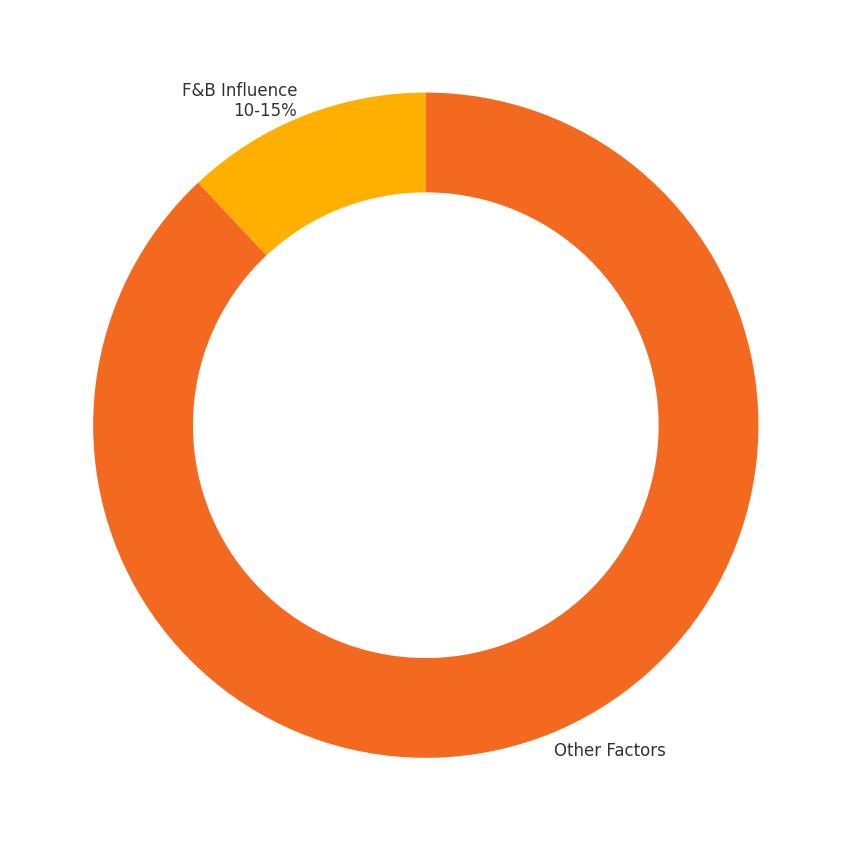
The Sustainability Shift
Compostable cutlery & trays
Carbon labeling pilots (UK, France)
AI-driven meal loading (-15% waste)
Plant-based menus on JetBlue, Lufthansa, Emirates
Waste segregation & lighter packaging
Cutting just 1 kg of catering weight per passenger can save about 1 ton of fuel annually across a global fleet—proof that small changes add up.
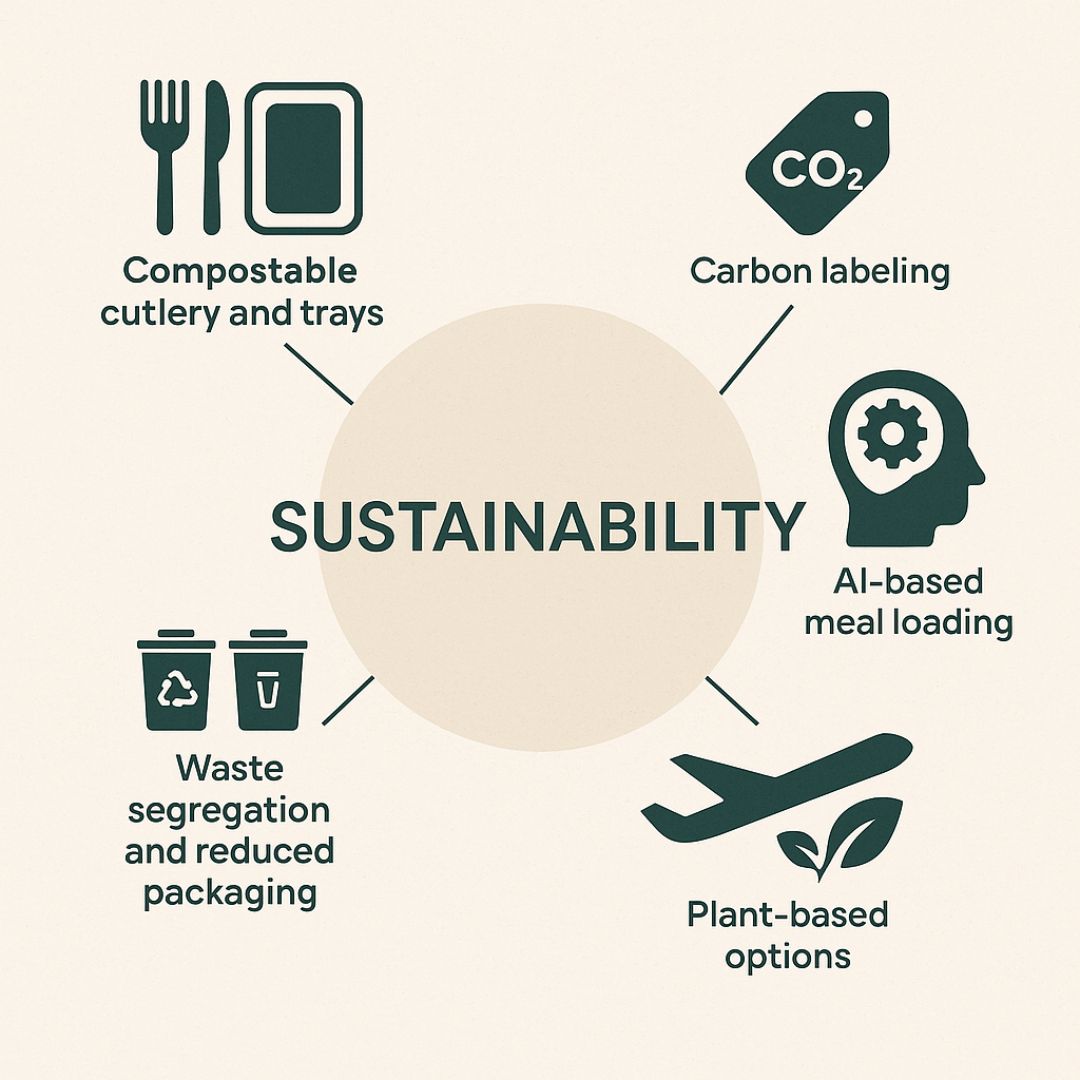
🇮🇳 India’s In-Flight Menus: A Taste of Home in the Sky
Air India – Tradition Meets Modern Taste
Full-service dining onboard domestic and international routes, blending classic favorites with new dietary innovations.
Domestic Flights
- ▶️ Hot multi-course meals on flights over 120 minutes (veg & non-veg).
- 👩🍳 Business Class features croissants, mushroom omelet, paneer paratha, medu vada, fish curry, Chettinad chicken, and Mumbai batata wada.
International Flights
- ✈️ One or more major/minor meals per flight segment based on duration.
- 🥗 New vegan & diabetic-friendly highlights: Thai red curry with tofu, broccoli millet steak, masala uttapam, quinoa kheer.
- 🍨 Desserts include Mango Passionfruit Delight, Espresso Almond Crumble, Khajur Tukda; paired with premium wines & spirits.
Special Meals (pre-book 24 hrs ahead)
AVML
Asian Vegetarian Meal
NVML
Non-Vegetarian Meal (Indian)
VJML
Vegetarian Jain Meal
VGML
Vegan Meal
DBML
Diabetic Meal
GFML
Gluten-Free Meal
CHML
Children’s Meal
BBML
Baby Bites Meal
HNML
Hindu Meal
MOML
Muslim Meal
KSML
Kosher Meal
What’s Next: Traceable, Transparent, Tailored
The next generation of airline dining goes beyond taste—delivering full visibility, personalization, and local flavor at 35,000 ft.
- Digitized: QR-code menus reveal ingredients, sourcing, and allergen data in real time.
- Personalized: AI-driven recommendations match meals to your frequent-flyer profile and past choices.
- Traceable: Pilot projects using blockchain let you trace each ingredient’s farm-to-tray journey.
- Localized: Partnerships with regional chefs and vendors bring authentic cultural flavors onboard.
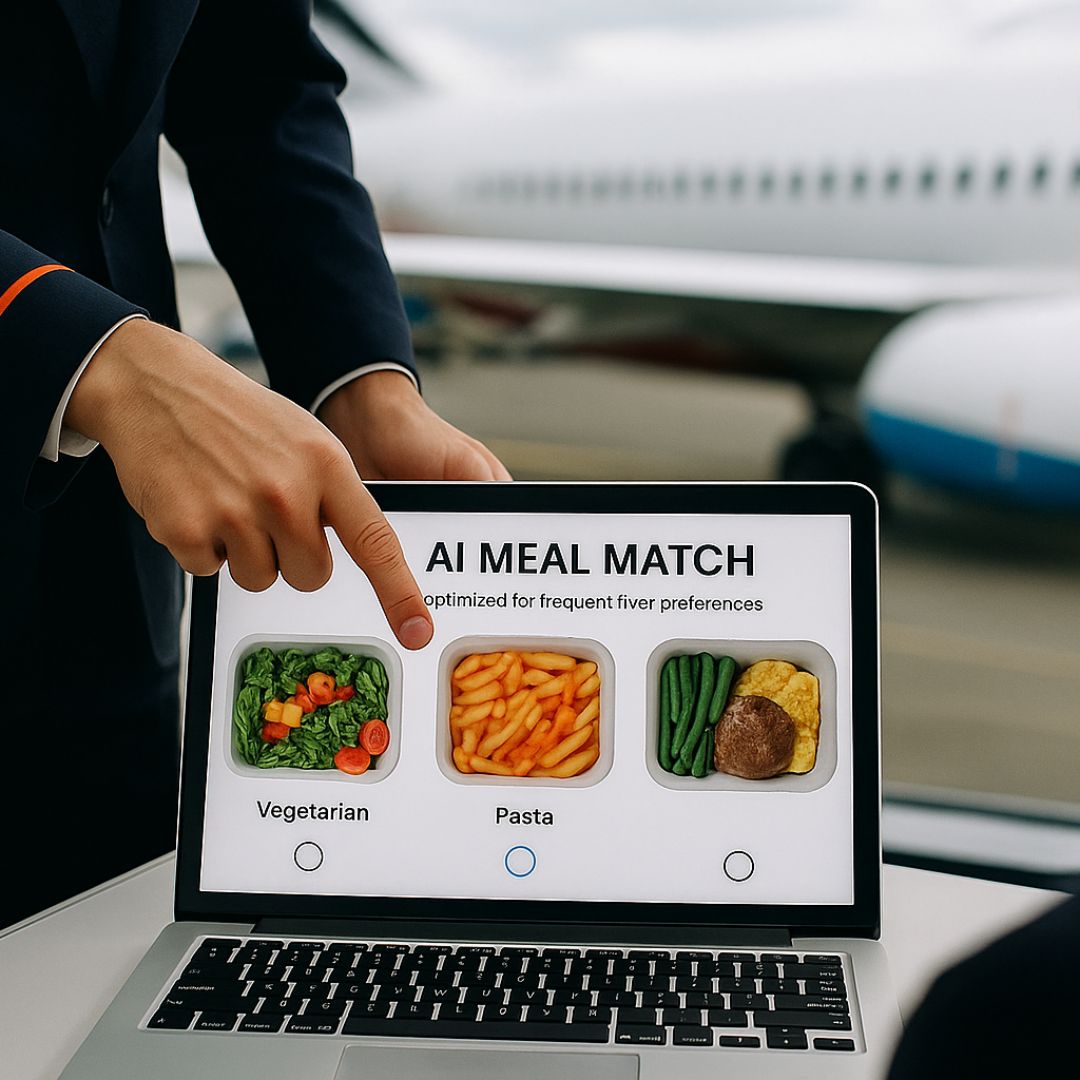
In India, look for tie-ups with homegrown brands—from artisanal chai chains to millet startups—smarter eco-packaging, and “green menu” options that reflect our climate priorities.
✈️ How Errakaaram™ Fits into the Airline Meal Evolution
1. The Shift Toward Clean Labels in the Sky
Airlines are removing preservatives and artificial additives, mirroring passenger demand for transparency. Errakaaram™’s bold, zero-preservative chutneys fit seamlessly as in-flight accompaniments.
Example: Lufthansa and Emirates now feature local clean-label dips. Errakaaram™ can be the Indian counterpart, delivering authentic chutneys with integrity.
2. Regional and Cultural Appeal
- •South Indian breakfasts (idli, dosa) with chutney pairings.
- •Fusion snacks (paratha wraps, masala sandwiches).
- •Stir-fry rice dishes onboard demanding flavor boosts.
Errakaaram™’s vegan-friendly small batches cater to both domestic and international carriers serving expats and gastronomic travelers.
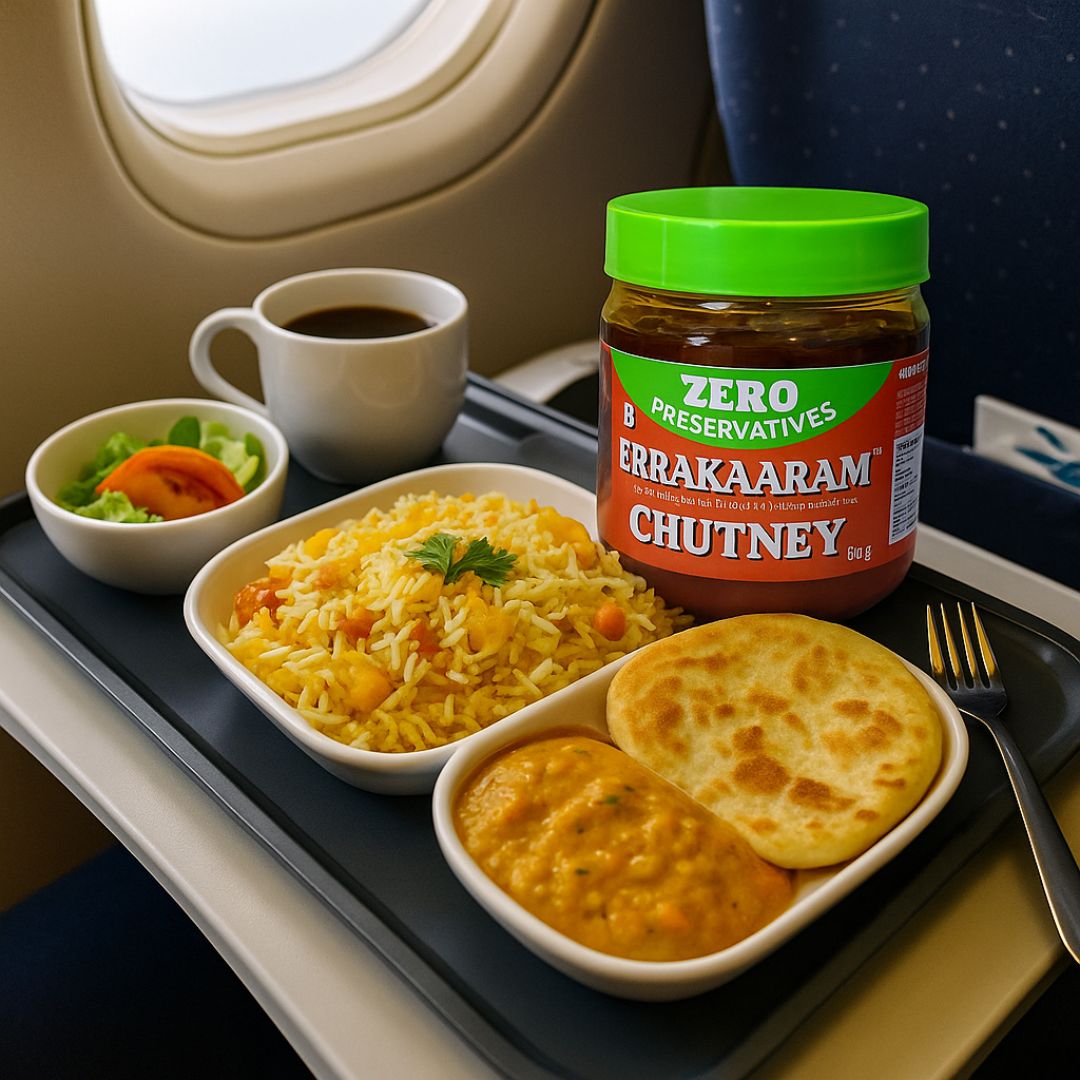
3. Packaging That Works Midair
4. Consumer Demand Alignment
- •Passengers scan ingredients midair via QR labels.
- •Demand clean, flavorful options even in economy cabins.
- •Value brands that balance authenticity with health consciousness.
Errakaaram™ isn’t just compatible—it’s highly relevant, meeting modern flyers’ needs for taste, transparency, and wellness.
Conclusion: The Meal as a Story
Airline food is more than calories at altitude—it’s a mirror of culture, regulation, innovation, and evolving passenger values. As taste meets tech and tradition meets traceability, those small trays tell ever bigger stories about origin, process, and purpose.
“As airlines pivot toward cleaner, more authentic food experiences, brands like Errakaaram™ feel less like an add-on and more like a fit. Born without preservatives and built on honest Indian spice, it’s easy to imagine chutney jars like these becoming part of the future of air travel—flavorful, rooted, and transparent.”
Next time you’re on a flight, don’t just eat—discover the story behind every bite.
You might also like

My Days with Errakaaram — A Fresh, Spicy, Versatile Journey in South Africa
21/11/2025
•8 min read
The Making of a Cult: Why Errakaaram™ Has Become a Cult Favorite Among Spice Lovers
14/10/2025
•8 min read
I Tried Replacing It. Nothing Came Close
10/10/2025
•5 min read
Errakaaram™: South India’s Fiery Chutney, Reimagined for Modern Kitchens
02/09/2025
•12 min read